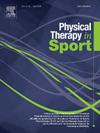前交叉韧带重建后,线性周期的阻力训练优于“3x10次方案”:一项随机对照试验
IF 2.2
3区 医学
Q1 REHABILITATION
引用次数: 0
摘要
目的探讨前交叉韧带重建术(ACLR)后线性周期化(LP)阻力训练的效果。SettingPhysiotherapy诊所。参与者:接受ACLR的小型休闲运动员。主要结果测量:膝关节伸屈肌等长强度、跳跃测试表现、患者报告的功能(国际膝关节文献委员会,IKDC)和心理准备(前十字韧带-损伤后恢复运动,ACL-RSI)。结果22名参与者(平均年龄27±6岁)随机分为LP方案和传统的“3x10代表方案”。与3x10组相比,LP组表现出更大的膝关节伸肌力量增加(p = 0.03): 51% (95% CI, 28 ~ 73)对26% (95% CI, 11 ~ 40)。LP组间膝关节屈肌力量增加无统计学差异(p = 0.11) (45%;95% CI, 18 ~ 71)和3x10组(23%;95% CI, 7 ~ 39)。ACLR后6个月,LP组表现出更大的膝关节伸肌肢体对称指数(97±10%比85±11%,p <;ACL-RSI评分较高(68±18比53±14,p = 0.04)。在跳跃性能和IKDC评分方面,组间无显著差异(p >;0.05)。结论在ACLR康复过程中,结合块结构LP的阻力训练方案比传统的“3x10次方案”更有效地增强膝关节伸肌力量和心理准备。本文章由计算机程序翻译,如有差异,请以英文原文为准。
Resistance training with linear periodization is superior to the ‘3x10 reps protocol’ after anterior cruciate ligament reconstruction: a randomized controlled trial
Objective
To investigate the effects of linear periodization (LP) resistance training after anterior cruciate ligament reconstruction (ACLR).
Setting
Physiotherapy clinic.
Participants
Male recreational athletes who underwent ACLR.
Main outcome measures
Knee extensor and flexor isometric strength, hop tests performance, patient-reported function (International Knee Documentation Committee, IKDC), and psychological readiness (Anterior Cruciate Ligament – Return to Sport after Injury, ACL-RSI).
Results
Twenty-two participants (mean age 27 ± 6 years) were randomized to either a LP program or the traditional '3x10 reps protocol'. The LP group demonstrated greater knee extensor strength gains compared to the 3x10 group (p = 0.03): 51 % (95 %CI, 28 to 73) vs. 26 % (95 %CI, 11 to 40). No statistically significant difference (p = 0.11) in knee flexor strength gains was observed between the LP group (45 %; 95 % CI, 18 to 71) and the 3x10 group (23 %; 95 % CI, 7 to 39). Six months after ACLR, the LP group exhibited a greater knee extensor limb symmetry index (97 ± 10 % vs. 85 ± 11 %, p < 0.01) and higher ACL-RSI scores (68 ± 18 vs. 53 ± 14, p = 0.04). No significant between-group differences were found in hop performance or IKDC scores (p > 0.05).
Conclusion
A resistance training program incorporating block-structured LP is more effective than the traditional ‘3x10 reps protocol’ in enhancing knee extensor strength and psychological readiness during ACLR rehabilitation.
求助全文
通过发布文献求助,成功后即可免费获取论文全文。
去求助
来源期刊

Physical Therapy in Sport
医学-康复医学
CiteScore
4.50
自引率
8.30%
发文量
125
审稿时长
39 days
期刊介绍:
Physical Therapy in Sport is an international peer-reviewed journal that provides a forum for the publication of research and clinical practice material relevant to the healthcare professions involved in sports and exercise medicine, and rehabilitation. The journal publishes material that is indispensable for day-to-day practice and continuing professional development. Physical Therapy in Sport covers topics dealing with the diagnosis, treatment, and prevention of injuries, as well as more general areas of sports and exercise medicine and related sports science.
The journal publishes original research, case studies, reviews, masterclasses, papers on clinical approaches, and book reviews, as well as occasional reports from conferences. Papers are double-blind peer-reviewed by our international advisory board and other international experts, and submissions from a broad range of disciplines are actively encouraged.
 求助内容:
求助内容: 应助结果提醒方式:
应助结果提醒方式:


